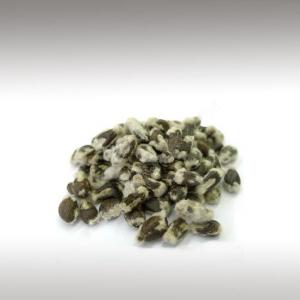
COTTONSEED OIL (GOSSYPIUM HIRSUTUM) - BASE OILS

BASE / GENERAL DATA
Information submited: October 1, 2014 Modified: April 4, 2018 By: OperaDreamhouse
Cottonseed oil is a cooking oil extracted from the seeds of Cotton plants of various species, mainly Gossypium Hirsutum and Gossypium Herbaceum, that are grown for Cotton fiber, animal feed, and oil.
Cottonseed oil has a mild taste and appears generally clear with a light golden color, the amount of color depending on the amount of refining.
Cottonseed oil has a smoke point of about 232 °C, and is high in tocopherols, which also contribute its stability, giving products that contain it a long shelf life, hence manufacturers proclivity to use it in packaged goods.
While crushing of Cottonseed for its oil was documented in the early Hindu medical books, and small crushes took place in European plants during the first part of the nineteenth century, it was the invention of the Cotton gin by Eli Whitney in 1794, and the need to deal with the Cottonseed left over after the fiber had been removed, that spurred innovations in oil crushing.
Chemical structure:
Itsfatty acid profile generally consists of 70% unsaturated fatty acids (18% monounsaturated, and 52% polyunsaturated), 26% saturated fatty acids. When it is fully hydrogenated, its profile is 94% saturated fat and 2% unsaturated fatty acids (1,5% monounsaturated, and 0,5% polyunsaturated).
According to the Cottonseed oil industry, Cottonseed oil does not need to be hydrogenated as much as other polyunsaturated oils to achieve similar results.
Gossypol is a toxic, yellow, polyphenolic compound produced by Cotton and other members of the order Malvaceae, such as okra. This naturally occurring coloured compound is found in tiny glands in the seed, leaf, stem, tap root bark, and root of the Cotton plant. The adaptive function of the compound facilitates natural insect resistance. The three key steps ofrefining, bleaching and deodorization in producing finished oil act to eliminate the gossypol level.
Cottonseed oil has a mild taste and appears generally clear with a light golden color, the amount of color depending on the amount of refining.
Cottonseed oil has a smoke point of about 232 °C, and is high in tocopherols, which also contribute its stability, giving products that contain it a long shelf life, hence manufacturers proclivity to use it in packaged goods.
While crushing of Cottonseed for its oil was documented in the early Hindu medical books, and small crushes took place in European plants during the first part of the nineteenth century, it was the invention of the Cotton gin by Eli Whitney in 1794, and the need to deal with the Cottonseed left over after the fiber had been removed, that spurred innovations in oil crushing.
Chemical structure:
Itsfatty acid profile generally consists of 70% unsaturated fatty acids (18% monounsaturated, and 52% polyunsaturated), 26% saturated fatty acids. When it is fully hydrogenated, its profile is 94% saturated fat and 2% unsaturated fatty acids (1,5% monounsaturated, and 0,5% polyunsaturated).
According to the Cottonseed oil industry, Cottonseed oil does not need to be hydrogenated as much as other polyunsaturated oils to achieve similar results.
Gossypol is a toxic, yellow, polyphenolic compound produced by Cotton and other members of the order Malvaceae, such as okra. This naturally occurring coloured compound is found in tiny glands in the seed, leaf, stem, tap root bark, and root of the Cotton plant. The adaptive function of the compound facilitates natural insect resistance. The three key steps ofrefining, bleaching and deodorization in producing finished oil act to eliminate the gossypol level.

SPIRITUAL PRACTISES DATA

MEDICINE / HEALTH DATA

BEAUTY / COSMETICS DATA

FOOD / COOKING DATA
COMMENTS
No comments.


